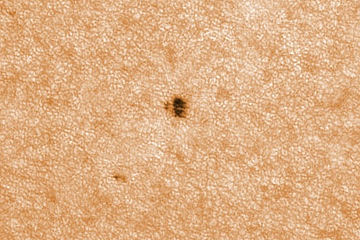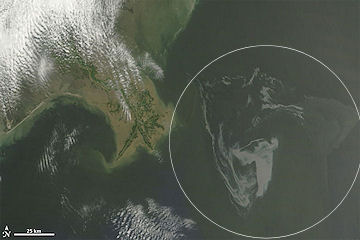NEW AND IMPROVED: Turn your iPhone or iPod Touch into a field-tested global satellite tracker. The Satellite Flybys app now works in all countries. | | | AURORA WATCH: High-latitude sky watchers should be alert for auroras on May 3rd. That's when a solar wind stream is due to hit Earth, possibly sparking geomagnetic storms around the poles. MAYDAY SUNSPOTS: A new sunspot, AR1064, is growing in the sun's northeastern quadrant. Just hours ago, Sascha Somodji photographed the Earth-sized active region from his backyard observatory in Krefeld, Germany: 
Somodji's exceptionally-clear photo shows a network of speckles dotting the sun's surface all around the sunspot. Those are solar granules, continent-sized masses of plasma rising and falling like water boiling on a hot stove. Sunspot 1064 has to push those boiling masses aside in order to expand--something it is busy doing right now. Meanwhile, another sunspot group (not yet numbered) is emerging near the sun's northeastern limb. Readers with solar telescopes are encouraged to monitor developments. more images: from Pete Lawrence of Selsey, West Sussex, UK; from Wouter Verhesen of Sittard,The Netherlands; from Andy Devey of Barnsley South Yorkshire England; from Cai-Uso Wohler of Bispingen, Germany; GULF OF MEXICO OIL SPILL: In the past 24 hours, BP's oil spill in the Gulf of Mexico has tripled in size to nearly 4000 square miles. The slick is so big, it is visible from space: 
NASA’s Terra satellite captured this natural-color image of the expandiing slick near the Mississippi Delta on May 1st. The outskirts of the spill are now reaching sensitive Gulf shore wetlands where the ecological impact could be severe. According to some estimates, as much as 210,000 gallons of crude oil a day are currently leaking into the Gulf, so the slick is only going to grow larger. Satellite images of Earth are usually beautiful. This is a rare exception. Check NASA's Earth Observatory for updates from orbit.
April Northern Lights Gallery
[previous Aprils: 2009, 2008, 2007, 2006, 2005, 2004, 2003, 2002] | 
